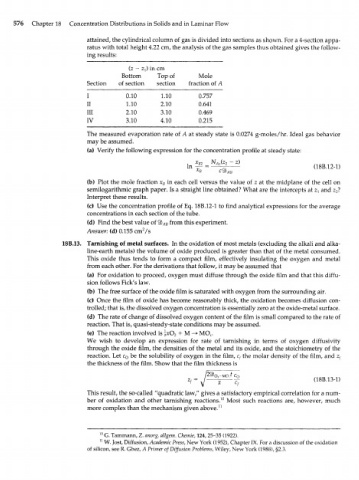Page 596 - Bird R.B. Transport phenomena
P. 596
576 Chapter 18 Concentration Distributions in Solids and in Laminar Flow
attained, the cylindrical column of gas is divided into sections as shown. For a 4-section appa-
ratus with total height 4.22 cm, the analysis of the gas samples thus obtained gives the follow-
ing results:
(Z - Zj) in cm
Bottom Top of Mole
Section of section section fraction of A
I 0.10 1.10 0.757
II 1.10 2.10 0.641
III 2.10 3.10 0.469
IV 3.10 4.10 0.215
The measured evaporation rate of A at steady state is 0.0274 g-moles/hr. Ideal gas behavior
may be assumed.
(a) Verify the following expression for the concentration profile at steady state:
(b) Plot the mole fraction x B in each cell versus the value of z at the midplane of the cell on
semilogarithmic graph paper. Is a straight line obtained? What are the intercepts at z ] and z ?
2
Interpret these results.
(c) Use the concentration profile of Eq. 18B.12-1 to find analytical expressions for the average
concentrations in each section of the tube.
(d) Find the best value of ЯЬ from this experiment.
АВ
2
Answer: (d) 0.155 cm /s
18B.13. Tarnishing of metal surfaces. In the oxidation of most metals (excluding the alkali and alka-
line-earth metals) the volume of oxide produced is greater than that of the metal consumed.
This oxide thus tends to form a compact film, effectively insulating the oxygen and metal
from each other. For the derivations that follow, it may be assumed that
(a) For oxidation to proceed, oxygen must diffuse through the oxide film and that this diffu-
sion follows Fick's law.
(b) The free surface of the oxide film is saturated with oxygen from the surrounding air.
(c) Once the film of oxide has become reasonably thick, the oxidation becomes diffusion con-
trolled; that is, the dissolved oxygen concentration is essentially zero at the oxide-metal surface.
(d) The rate of change of dissolved oxygen content of the film is small compared to the rate of
reaction. That is, quasi-steady-state conditions may be assumed.
(e) The reaction involved is \xO 2 + M —> МО .
Л
We wish to develop an expression for rate of tarnishing in terms of oxygen diffusivity
through the oxide film, the densities of the metal and its oxide, and the stoichiometry of the
reaction. Let c be the solubility of oxygen in the film, c the molar density of the film, and Z(
o f
the thickness of the film. Show that the film thickness is
This result, the so-called "quadratic law/ gives a satisfactory empirical correlation for a num-
7
ber of oxidation and other tarnishing reactions. 10 Most such reactions are, however, much
more complex than the mechanism given above. 11
10
G. Tammann, Z. anorg. allgem. Chemie, 124, 25-35 (1922).
11
W. Jost, Diffusion, Academic Press, New York (1952), Chapter IX. For a discussion of the oxidation
of silicon, see R. Ghez, A Primer of Diffusion Problems, Wiley, New York (1988), §2.3.

